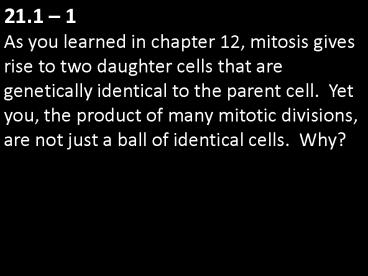Wednesday, September 5 PowerPoint PPT Presentation
1 / 18
Title: Wednesday, September 5
1
21.1 1 As you learned in chapter 12, mitosis
gives rise to two daughter cells that are
genetically identical to the parent cell. Yet
you, the product of many mitotic divisions, are
not just a ball of identical cells. Why?
2
21.1 1 Cells undergo differentiation during
embryonic development, becoming different from
each other in the adult organism, there are many
highly specialized cell types.
3
21.1 2 What are the fundamental differences
between plants and animals in their mechanisms of
development?
4
21.1 2 During animal development, movement of
cells and tissues is a major mechanism, which is
not the case in plants. In plants, growth and
morphogenesis continue throughout the life of the
plant. This is true only of a few types of
animal cells.
5
21.2 1 Why cant a single embryonic stem cell
develop into an embryo?
6
21.2 1 Information deposited by the mother in
the egg (cytoplasmic determinants) is required
for embryonic development.
7
21.2 2 If you clone a carrot, will all the
progeny plants (clones) look identical? Why or
why not?
8
21.2 2 No, primarily because of the subtle (and
not-so-subtle) differences in their environments.
9
21.2 3 The signal molecules released by an
embryonic cell can induce changes in a
neighboring cell without entering the cell. How?
10
21.2 3 By binding to a receptor on the
receiving cells surface and triggering a signal
transduction pathway that affects gene expression.
11
21.3 1 Why are fruit fly maternal effect genes
also called egg-polarity genes?
12
21.3 1 Because their products, made by the
mother, determine the head and tail ends, as well
as the back and belly, of the egg (and eventually
the adult fly).
13
21.3 2 If a researcher removes the anchor cell
from a C. elegans embryo, the vulva does not
form, even though all the cells that would have
made the vulva are present. Explain why.
14
21.3 2 The prospective vulval cells require an
inductive signal from the anchor cell before they
can differentiate into vulval cells.
15
21.3 3 Explain why cutting and rooting a shoot
from a plant, then planting it successfully,
provides evidence that plant cells are totipotent.
16
21.3 3 A shoot is a differentiated structure,
yet some of the cells that make it up are able to
differentiate and redifferentiate, forming all of
the organs of the new plant.
17
21.4 1 The DNA sequences called homeoboxes,
which help homeotic genes in animals direct
development, are common to flies and mice. Given
this similarity, explain why these animals are so
different.
18
21.4 1 Homeotic genes differ in their
nonhomeobox sequences, which determine their
interactions with other transcription factors and
hence which genes are regulated by the homeotic
genes. These interactions differ in the two
organisms, as do the expression patterns of the
homeobox genes.

